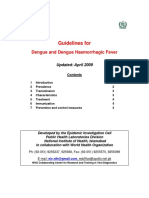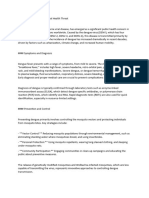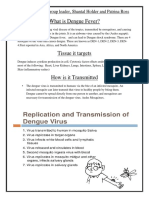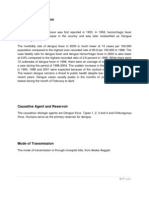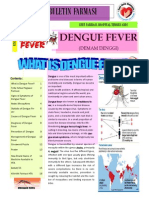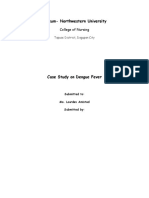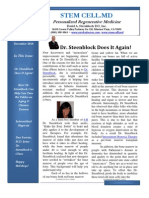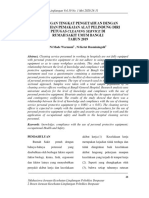0 ratings0% found this document useful (0 votes)
Dengue Inglés
Dengue Inglés
Uploaded by
Gohan MiguelDengue is a mosquito-borne viral infection spread by the Aedes aegypti mosquito. It causes flu-like symptoms and occasionally severe bleeding or organ impairment. While there is no vaccine or specific treatment, early medical care and symptom relief lowers the risk of fatality. Prevention relies on reducing mosquito habitats and bites through environmental management, covering water containers, and using repellents and protective clothing. Dengue affects tropical and subtropical regions globally and cases have increased dramatically in recent decades.
Copyright:
© All Rights Reserved
Available Formats
Download as DOCX, PDF, TXT or read online from Scribd
Download as docx, pdf, or txt
Dengue Inglés
Dengue Inglés
Uploaded by
Gohan Miguel0 ratings0% found this document useful (0 votes)
Dengue is a mosquito-borne viral infection spread by the Aedes aegypti mosquito. It causes flu-like symptoms and occasionally severe bleeding or organ impairment. While there is no vaccine or specific treatment, early medical care and symptom relief lowers the risk of fatality. Prevention relies on reducing mosquito habitats and bites through environmental management, covering water containers, and using repellents and protective clothing. Dengue affects tropical and subtropical regions globally and cases have increased dramatically in recent decades.
Copyright
© © All Rights Reserved
Available Formats
DOCX, PDF, TXT or read online from Scribd
Share this document
Did you find this document useful?
Is this content inappropriate?
Dengue is a mosquito-borne viral infection spread by the Aedes aegypti mosquito. It causes flu-like symptoms and occasionally severe bleeding or organ impairment. While there is no vaccine or specific treatment, early medical care and symptom relief lowers the risk of fatality. Prevention relies on reducing mosquito habitats and bites through environmental management, covering water containers, and using repellents and protective clothing. Dengue affects tropical and subtropical regions globally and cases have increased dramatically in recent decades.
Copyright:
© All Rights Reserved
Available Formats
Download as DOCX, PDF, TXT or read online from Scribd
Download as docx, pdf, or txt
0 ratings0% found this document useful (0 votes)
Dengue Inglés
Dengue Inglés
Uploaded by
Gohan MiguelDengue is a mosquito-borne viral infection spread by the Aedes aegypti mosquito. It causes flu-like symptoms and occasionally severe bleeding or organ impairment. While there is no vaccine or specific treatment, early medical care and symptom relief lowers the risk of fatality. Prevention relies on reducing mosquito habitats and bites through environmental management, covering water containers, and using repellents and protective clothing. Dengue affects tropical and subtropical regions globally and cases have increased dramatically in recent decades.
Copyright:
© All Rights Reserved
Available Formats
Download as DOCX, PDF, TXT or read online from Scribd
Download as docx, pdf, or txt
You are on page 1/ 2
1. Dengue is a mosquito-borne viral infection.
The virus responsible for causing
dengue, is called dengue virus (DENV). There are four DENV serotypes,
meaning that it is possible to be infected four times.
2. Dengue is found in tropical and sub-tropical climates worldwide, mostly in
urban and semi-urban areas. Dengue is widespread throughout the tropics, with
local variations in risk influenced by rainfall, temperature, relative humidity and
unplanned rapid urbanization.
3. Dengue is a severe, flu-like illness that affects infants, young children and
adults, but seldom causes death. Symptoms usually last for 2–7 days, after an
incubation period of 4–10 days after the bite from an infected mosquito. The
World Health Organization classifies dengue into 2 major categories: dengue
(with / without warning signs) and severe dengue.
4. Dengue should be suspected when a high fever (40°C/104°F) is accompanied by
2 of the following symptoms during the febrile phase:
severe headache
pain behind the eyes
muscle and joint pains
nausea
vomiting
swollen glands
rash.
5. Severe dengue is a potentially fatal complication, due to plasma leaking, fluid
accumulation, respiratory distress, severe bleeding, or organ impairment. Severe
dengue is a leading cause of serious illness and death in some Asian and Latin
American countries. It requires management by medical professionals.
6. There is no specific treatment for dengue/severe dengue. Early detection of
disease progression associated with severe dengue, and access to proper medical
care lowers fatality rates of severe dengue to below 1%. Fever reducers and pain
killers can be taken to control the symptoms of muscle aches and pains, and
fever.
7. Dengue prevention and control depends on effective vector control measures.
Sustained community involvement can improve vector control efforts
substantially. At present, the main method to control or prevent the transmission
of dengue virus is to combat the mosquito vectors.
8. Prevention of mosquito breeding:
Preventing mosquitoes from accessing egg-laying habitats by environmental
management and modification;
Disposing of solid waste properly and removing artificial man-made habitats that
can hold water;
Covering, emptying and cleaning of domestic water storage containers on a
weekly basis;
Applying appropriate insecticides to water storage outdoor containers
9. Personal protection from mosquito bites:
Using of personal household protection measures, such as window screens,
repellents, insecticide treated materials, among others. These measures must be
observed during the day both inside and outside of the home because the primary
mosquito vectors bites throughout the day.
Wearing clothing that minimises skin exposure to mosquitoes is advised
10. Community engagement:
Educating the community on the risks of mosquito-borne diseases;
Engaging with the community to improve participation and mobilization for
sustained vector control
11. The global incidence of dengue has grown dramatically in recent decades.
About half of the world's population is now at risk. There are an estimated 100-
400 million infections each year. The largest number of dengue cases ever
reported globally was in 2019.
You might also like
- Guidelines For: Dengue and Dengue Haemorrhagic FeverNo ratings yetGuidelines For: Dengue and Dengue Haemorrhagic Fever4 pages
- Dengue Fever Prevention Most RecommendedNo ratings yetDengue Fever Prevention Most Recommended2 pages
- Prevention and Treatment of Dengue Virus InfectionNo ratings yetPrevention and Treatment of Dengue Virus Infection8 pages
- Group#1 (Vector Born Disease & Control StratgiesNo ratings yetGroup#1 (Vector Born Disease & Control Stratgies24 pages
- Dengue Is A Common Viral Infection Spread by Mosquitoes. It Is Widespread in Tropical and Sub-Tropical RegionsNo ratings yetDengue Is A Common Viral Infection Spread by Mosquitoes. It Is Widespread in Tropical and Sub-Tropical Regions2 pages
- Teaching Plan: Learning Content: Topic: Dengue AwarenessNo ratings yetTeaching Plan: Learning Content: Topic: Dengue Awareness4 pages
- Philippines General Health Risks: Dengue: Klausmieir Candis Villegas BSN 2-A March 2, 2019No ratings yetPhilippines General Health Risks: Dengue: Klausmieir Candis Villegas BSN 2-A March 2, 20194 pages
- Emerging and Reemerging Diseases - Programs and Policies On Communicable Diseases100% (1)Emerging and Reemerging Diseases - Programs and Policies On Communicable Diseases34 pages
- Understanding Diseases a Comprehensive Overview.pptx[1]No ratings yetUnderstanding Diseases a Comprehensive Overview.pptx[1]14 pages
- The Complete Guide to Monkeypox: Causes, Symptoms, Treatment & Prevention.From EverandThe Complete Guide to Monkeypox: Causes, Symptoms, Treatment & Prevention.No ratings yet
- The Coronavirus Pandemic: Essential Guide to Understand & Protect Yourself from COVID-19From EverandThe Coronavirus Pandemic: Essential Guide to Understand & Protect Yourself from COVID-19No ratings yet
- Europ Assistance Visa Europe Limited: You Live, We CareNo ratings yetEurop Assistance Visa Europe Limited: You Live, We Care17 pages
- Meta-Analysis On The Effect of Zinc On Reducing Diarrhea Episode in ToddlersNo ratings yetMeta-Analysis On The Effect of Zinc On Reducing Diarrhea Episode in Toddlers9 pages
- Clinical Evaluation of Purified Shilajit On TestosteroneNo ratings yetClinical Evaluation of Purified Shilajit On Testosterone6 pages
- Region VIII - Eastern Visayas Quickstat On: Philippine Statistics AuthorityNo ratings yetRegion VIII - Eastern Visayas Quickstat On: Philippine Statistics Authority3 pages
- Understanding The Therapeutic Alliance in Stroke RehabilitationNo ratings yetUnderstanding The Therapeutic Alliance in Stroke Rehabilitation11 pages
- Parenting Success: The Things I Wished I Knew Before I Started ParentingNo ratings yetParenting Success: The Things I Wished I Knew Before I Started Parenting9 pages
- CLINIC Newsletter - November-December 2010 - Final RevisionNo ratings yetCLINIC Newsletter - November-December 2010 - Final Revision4 pages
- Hubungan Tingkat Pengetahuan Dengan Kepatuhan Pemakaian Alat Pelindung Diri Petugas Cleaning Service Di Rumah Sakit Umum Bangli TAHUN 2019No ratings yetHubungan Tingkat Pengetahuan Dengan Kepatuhan Pemakaian Alat Pelindung Diri Petugas Cleaning Service Di Rumah Sakit Umum Bangli TAHUN 20198 pages
- Different Field of Nursing: Geronimo C. Burce JRNo ratings yetDifferent Field of Nursing: Geronimo C. Burce JR44 pages
- Sav Research: Date Script LOT Call LevelNo ratings yetSav Research: Date Script LOT Call Level27 pages
- List of Ayurvedic Manufacturing Units of West BengalNo ratings yetList of Ayurvedic Manufacturing Units of West Bengal7 pages
- Work Procedure For CCB Scaffolding - Complete FileNo ratings yetWork Procedure For CCB Scaffolding - Complete File167 pages

